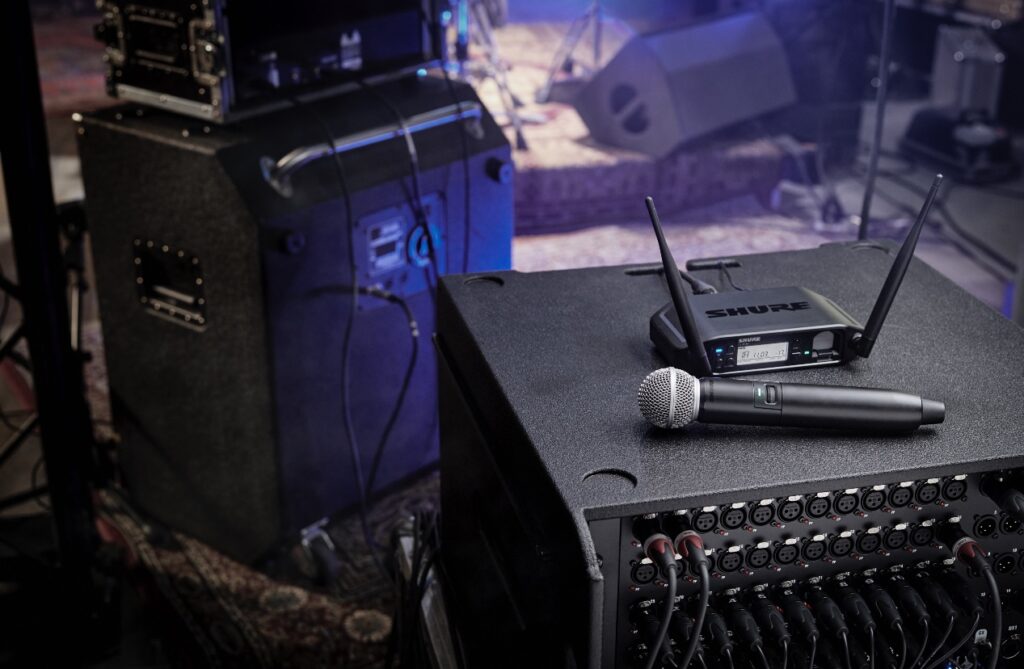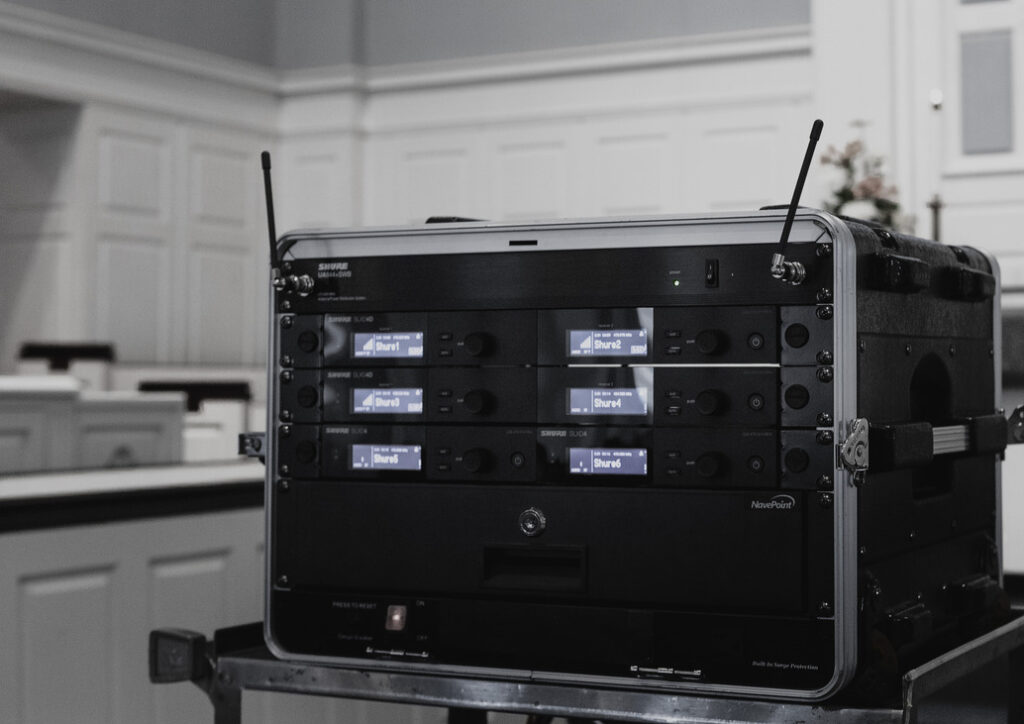Shure’s Wireless Systems Let You Off the Leash

If you have reached the stage of the game where you need to start taking a more professional approach to your audio, one of the best ways to level up is by upgrading to a wireless system.
If that’s you, then you’re probably asking yourself questions like who makes the best system?; what system is right for me?; and where do I even start?. Well, you’re reading the right article, because we have the answers to all those questions and more.
As you no doubt know, all wireless system consists of two essential components: a transmitter and a receiver. The transmitter connects to the sound capture source (like a microphone or electric guitar) and the receiver routes that audio signal to the destination (typically an amplifier or a channel on a mixer). Basically, instead of needing a cable to get the sound from you to the amp, you wirelessly transmit it over a specific frequency range.
This untethering from cables is a very freeing experience – so much so that most people who go wireless wonder how they ever managed before. Now, thanks to the legendary microphone brand Shure, finding the right system for you is easy.
Shure’s wireless systems are all suited to specific applications, and are available in handheld, lavalier (clip-on), headset, gooseneck, and guitar options. Simply browse their products based on your needs and budget, and you’re away!
There are nearly a dozen series in Shure’s wireless family, from the super high-end Axient Digital range – used in mega live events going out to millions of people – to the newly-released MoveMic series that equips today’s mobile content creators with world-class clip-on microphones that upgrade portable digital devices to broadcast-quality.
In this overview, we are looking at three ranges in particular that focus on music and vocal performance, whether it is in a local club, a boardroom, a house of worship, or your city’s biggest arena. These are the BLX, GLX-D+, and SLX-D series, each of which features 20+ configurations of transmitters and receivers, as well as the Shure trademarks of durability, reliability, and legendary audio quality.

BLX
BLX
Starting from $649, the BLX series is perfect for small bands, assemblies, or performers taking their first step into the world of wireless freedom. Offering the most simple scan set up, this UHF system provides a range of 90 metres (300 feet) across a maximum of 12 systems per band. Thanks to its AA power pack, it has up to 14 hours battery life – more than enough for several gigs, soundchecks, and rehearsals per go.
GLX-D+ Dual Band
With an entry point of $679, GLX-D+ is a middle-tier series, and thus best suited to situations requiring more bandwidth and a higher quality sound transmission – usually meaning a bigger stage. Like the BLX, it has a simple scan setup, making it quick and easy to use.
In terms of where it steps up, the GLX-D+ series provides a maximum of 5/11 systems across its two channels – broadcasting at 2.4/5.8 GHz – over a range of up to 30 metres (100 feet). Its SB904 lithium ion has a maximum battery life of up to 12 hours, and is fully rechargeable. The GLX-D+ also features an automatic frequency system that means handling multiple connections is a breeze.

GLX-D+
SLX-D
The higher end series of the three, the SLX-D starts at $1,479, but really delivers extra bang for those bucks. In many ways it offers the best of both the BLX and GLX-D+, such as providing a combined AA battery and rechargeable SB903 lithium ion (with an 8 hour life). With a range of 100 metres (330 feet), the SLX-D is the big kahuna, offering a maximum 10 systems per 6MHz channel, and 32 systems per 44 MHz channel.
Like its two counterparts, setup is dead easy with the SLX-D, which features ethernet control (connected to systems like AMX, Crestron or Digital Signal Processors), and deploys frequencies over infrared – meaning the fastest and most reliable sync. It has an equally easy-to-use multi-system management, and works seamlessly with the ShurePlus Channels app for keeping track of your wireless inventory, and monitoring channels in real time.
Configurations
The BLX, GLX-D+, and SLX-D series each come in dozens of configurations, featuring different single and dual-channel receivers, single and dual transmitters, and accessories such as microphone clips, AA batteries, power supplies, and user guides.
Receivers
BLX4 (tabletop single-channel)
BLX4R (half-rack single-channel)
BLX88 (tabletop dual-channel)
GLXD4+ (dual-band tabletop dual-channel)
GLXD4R+ (dual-band half-rack dual-channel)
GLXD6+ (guitar pedal)
SLXD4 (single-channel)
SLXD4D (dual-channel)
SLXD5 (single portable)
Transmitters
BLX1 (bodypack transmitter)
BLX2/PG58 (handheld transmitter with PG58 mic capsule)
BLX2/SM58 (handheld transmitter with SM58 mic capsule)
BLX2/B58 (handheld transmitter with Beta58A mic capsule)
GLXD1+ (dual-band bodypack transmitter)
GLXD2/SM58 (dual-band handheld transmitter with SM58 mic capsule)
GLXD2/B58 (dual-band handheld transmitter with Beta58A mic capsule)
GLXD2/B87A (dual-band handheld transmitter with Beta87A mic capsule)
SLXD1 (bodypack transmitter)
SLXD2/SM58 (handheld transmitter with SM58 mic capsule)
SLXD2/B58 (handheld transmitter with Beta58A mic capsule)
SLXD2/B87A (handheld transmitter with Beta87A mic capsule)
SLXD3 (plug-on transmitter)
Microphones
WB98H/C (gooseneck instrument)
Beta 98H/C (gooseneck instrument)
CVL (lavalier)
DL4 (lavalier)
DL4B (lavalier)
MX153 (earset)
PGA31 (headset)
SM31FH (headset)
SM35 (headset)
UL4B (lavalier)
WL185 (lavalier)
WL93 (lavalier)
Cables
WA302 (instrument cable)
WA305 (premium instrument cable)

SLX-D
As you can see, the capabilities of each Shure wireless system increase with the nature of its usage, making it easier to select the right one for you.
If you found yourself wondering what a lot of the SLX-D features even do, then the more streamline GLX-D+ and BLX systems are likely the best fit for your needs. If, however, your live music, theatre, events or conferences require the ultimate in reliability, flexibility and ease of use, then the SLX-D range is recommended.
And this is just scratching the surface of the Shure wireless range!
To dive in deeper, head to the Shure website where you will find an abundance of technical details, videos and comparisons between all of the Shure wireless systems. Not only that, but the Shure website features a vast answer database, user guides, downloads, support, and a tech portal where you can find all of Shure’s product documentation, software, firmware, tools and resources.
Find out more at Shure’s official website.






























